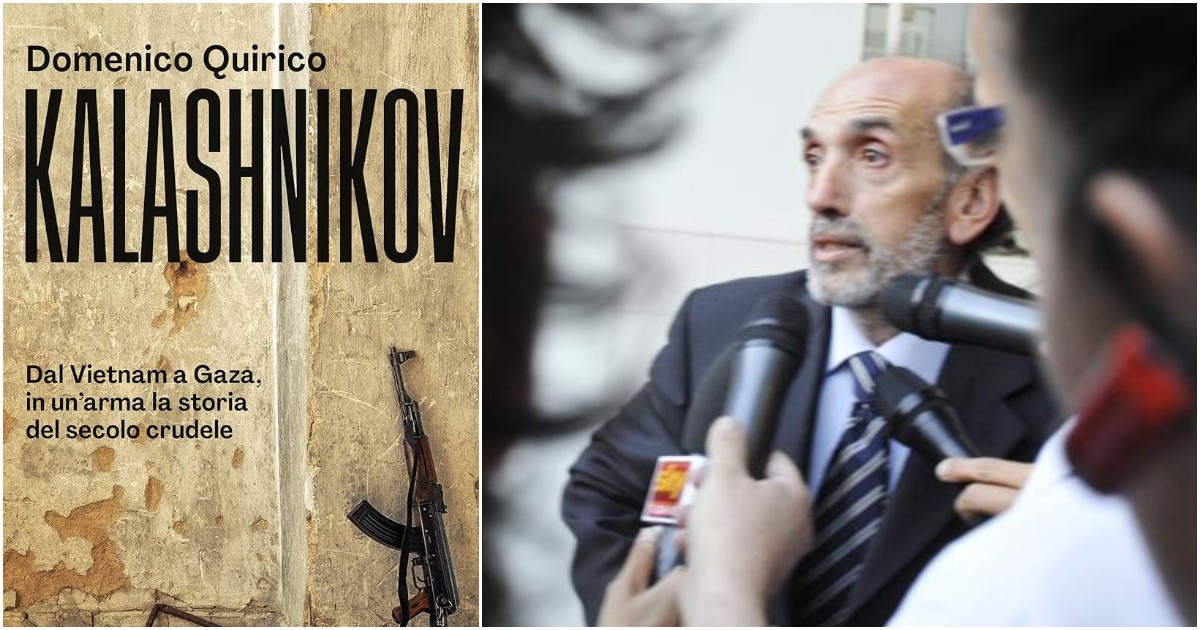For work reasons I often had to film videos kalashnikov: in the Middle East, in Africa, in the Caucasus, in the Balkans. But there is one that I cannot forget: reduced to a wreck and half melted by the bombs, he was hanging from Beirut, in 1986, on a wall of the Lebanese Communist Party headquarters. He reminded the rare visitors that almost all the party members had fallen fighting the Israeli invasion of ’82.
It came to mind while I was reading Kalashnikov, the latest book by Domenico Quirico. Envoy of The print, Quirico said almost all the conflicts of our time collecting an endless series of journalistic awards and trips to hell. Kalashnikov retraces them using it as a key to understanding lâarma which globalized the war, which made it “portable†accompanying its chilling mutations from a war of liberation to a war of extermination. Until the massacre of October 7th. The pogrom begins precisely with the “subjective” of a Kalashnikov recorded by the bodycam of a Hamas militiaman who, on a motorbike, runs screaming with joy towards a rave party. It will be transformed into a slaughterhouse, Quirico writes, also because the young people who danced had grown up more like Europeans than Israelis, that is, they had put the war behind them and, unlike their fathers, they had gone to the party, two km from Hamas, without bringing their machine guns.
Also read from Diwan’s blog
Gaza writes back, the collection that Refaat Alareer leaves behind is a testimony: ‘Writing, an obligation’
This ârimozione pacifistaâ produced the next scene which, filmed from a security camera, resembles the executions of Babij Jar (1): a militiaman chases two girls, the first is mowed down while the second, blocked by an embankment, kneels and asks for mercy. The soldier of God stops, calmly reloads, takes aim and kills her.
“Palestine and the Near East – writes Quirico – are land of disappeared civilizations who have left buried concentrated, grandiose and impressive illustrations of themselves, a dense fabric of evocative signs that extends everywhere. I can imagine that in a century the tunnels of Hamasthe concrete labyrinth built by God’s warriors, whatever the outcome of this endless struggle by awakening the Palestinians, will become another section of this catacombal occult world.”
Starting from the history of the most widespread weapon and the biography of its inventor, the worker-soldier Michail KalashnikovQuirico moves like a diviner, searches for the underground sources of History, continually oscillating between past and present, especially when the Past imprisons the Future: “Israelis and Palestinians – he writes – at every bloody chapter, raise their respective ‘historical’ reasons descending to the Bible and Saladin and terrible memories mixed with blood. To overcome them in a mutual understanding it would be necessary to impose the rigid condition that was given to Orpheus to bring Eurydice back to life: do not turn around otherwise Eurydice will vanish forever. Like Orpheus, Israelis and Palestinians stubbornly continue to turn backâ.
It is this diachronic reading that allows him to see, behind the asymmetric strategies of drones and hacker, the monstrous mutation produced by war in Ukraine: the return to Verdun, to the slow and inexorable industrial slaughter of the First World War.
“He was actually right Clausewitz – he writes – when he invited us not to forget that the only animal that war resembles is the chameleon. In Ukraine, sixty-year-olds are enlisting, in Russia the prisons are being cleared… When Ukraine will be without troops we will have to send our kids to replace them if we don’t want to leave the field to Putin’s infinite human resources. The monstrous losses? Today, as in 1915, just don’t reveal them. Men are nothing. An entire Russian and Ukrainian youth aspirated, swept away. The figures from the morgues and cemeteries are the only data that gives the true meaning of the war. We need to go back to the high intensity massacres of the last century… It seems that war is a blind force of nature which can neither be understood nor controlled and whose development cannot be predicted… After two years we are looking for new doctrines which will shake this horrible immobility of the massacre but who can guarantee that the instinct of conservation this time too will avoid always atomic catastrophes?†.
Read Also
The numbers of the war: 190 thousand Ukrainian and Russian deaths, 160 billion wasted and zero progress
In his studies on Historical roots of fairy tales Stopper talk about the âoggetti magiciâ with which the Hero of the tale defeats the Dragon; well, the Kalashnikov in Quirico’s book is interpreted to all intents and purposes as a magical object because it is the crystallization of Power. Theodor Adorno wrote that strength is the ability to transform a man into a corpse. The Kalashnikov is the most popular, most widespread (most “sustainable” we would say today) object that gives anyone a power of life and death. And precisely for this reason it contaminates him…
“If my weapon was used to oppress the people – confesses Mikhail Kalashnikov at the end of the imaginary autobiography traced by Quirico – I’m not to blame. Even if I wanted to, I could not have saved the lives of the just or the unjust. I followed my destiny you might say. Now that invention that was used for defend my homeland it has become the favorite weapon of bandit terrorists. Can I pretend nothing happened again? “
(1) Babij Jar is the place where 33,771 Kiev Jews were killed between 29 and 30 September 1941. The most shocking images are those of women’s executions.
